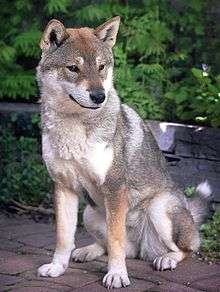Shikoku (dog)
 | |||||||||||||||||||||||||
| Other names | Kochi-ken, Mikawa Inu, Japanese Wolfdog | ||||||||||||||||||||||||
|---|---|---|---|---|---|---|---|---|---|---|---|---|---|---|---|---|---|---|---|---|---|---|---|---|---|
| Origin | Japan | ||||||||||||||||||||||||
| |||||||||||||||||||||||||
| Domestic dog (Canis lupus familiaris) | |||||||||||||||||||||||||
The Shikoku (四国犬 Shikoku-ken, alternative names: Kochi-ken, Mikawa Inu, Japanese Wolfdog) is a native, primitive Japanese breed of dog from Shikoku island that is similar to a Shiba Inu. The Shikoku was recently added as recognized breed of the American Kennel Club as an AKC FSS standard [ Foundation Stock Service ], it is recognized by the Japan Kennel Club, an organization recognized by AKC as an official foreign registry[1] (AKC recognizes the Shiba Inu, however). The Shikoku is also in the Canadian Kennel Club Hound group and the United Kennel Club, awaiting full recognition. In 1937 the Japanese Crown recognized the Shikoku dog as a living "natural monument" of Japan.[2]
Comparison to other Japanese breeds
The Shikoku is one of the native Japanese breeds intermediate in size between the large Akita Inu and the small Shiba Inu; all are within the Spitz family of dogs. The Shikoku was bred mainly for hunting deer and boar in the mountainous districts of Kochi Prefecture. It is sometimes called "Kochi-ken" and, along with the Kai dog, referred to as a deerhound.
A study of the 1930s carried out by the Japanese cynologist[3] Haruo Isogai classified all native Japanese dog breeds into three categories: large-, medium-, and small-sized. The Shikoku belongs to the Shika-inus, the medium-sized dogs. Other medium-sized dogs are the Kai Ken, the Ainu and the Kishu Inu. They are all very similar with overlapping colors and only minor differences in size and morphology.
Characteristics and temperament

It is cautious and brave with good judgment. It is also loyal to its master. It has sharper features than most Japanese dogs and is sometimes allowed to chase wild boar so it will maintain its nature.
Shikoku dogs are tough and sufficiently agile to run through a mountainous region. They are the ideal companion for active outdoor people. They are very energetic and active outside but they are calm and quiet indoors. The Shikoku is a very intelligent dog and a quick learner. They are not as stubborn and independent as the other native Japanese breeds, but still it is not a dog for every person.
The Shikoku stands 17–21 inches (43–53 cm) high and comes in sesame (red, black), black and tan (nonstandard color), or cream (nonstandard color). These colors consist usually of a light brown, a light red-brown, or a light black-brown. In addition, there is a cream colored coat that tends to be very rare. In all of these colors there is usually a mixture of white found around the underside of the body, near the eyes, snout, and legs. The Shikoku tends to shed its coat at least one to two times a year. The dog has a fairly thick coat with pointed ears and a curved tail. The body conformation is typically of the spitz-type: the square body, the wedge-shaped head, the prick triangular ears, and feathered curled tail.
The Shikoku dog is somewhat unique in its appearance. It looks similar to an Alaskan Husky dog physically, but differs in its size and color. The Shikoku Inu ranges from thirty to fifty-five pounds (male; approximately 20 inches tall; female; approximately 18.5 inches tall). This dog would be considered medium-sized.
Varieties
Three varieties of this breed have been identified: the Awa, the Hongawa, and the Hata all named after the area where they were bred on the island of Shikoku. The Hongawa breeding area being the most remote and least accessible, the dogs of the Hongawa line maintained the highest degree of purity and was considered the best type.
Health
With a life span of ten to twelve years or so, Shikoku need to be properly taken care of, like every other dog. Health is a big part of the Shikoku's life because dogs such as these suffer from common illnesses when not given a proper diet or sufficient exercise.[4] Common diseases in the Shikoku can appear in the bones, joints, ears, muscles, and nerves.[5] Illnesses also occur from things such as trauma and infection. Other more serious issues relate to heart, lung, digestive, and urinary problems.
In popular culture
The anime-only characters of the series Ginga Legend Weed Ryo, Ryu, Heita, and Hanji (four dogs shown aiding Jerome) may be Shikoku. The series is by Yoshihiro Takahashi.
References
- ↑ "Pet Publishing - Online Pet Media". Pet Publishing.
- ↑ "Archived copy". Archived from the original on December 8, 2006. Retrieved November 22, 2006.
- ↑ Haruo Isogai was a dog breeder who worked up a classification system for Japanese dogs based on appearance, as a nationalist response to the adoption by dog enthusiasts in Japan of European breeds in the 1930s. ( in Dutch) ( in German) There is no evidence that he had any relevant scientific training or even that he ever called himself a "cynologist".
- ↑ http://www.akc.org/dog-breeds/shikoku/care/#energy
- ↑ http://www.akc.org/dog-breeds/shikoku/care/#health
External links
| Wikimedia Commons has media related to Shikoku (dog). |
- First Shikoku Dog
- Shikoku Canada
- Shikoku Dog Website
- Shikoku Inu @ The Canine Information Library
- North American Shikoku Club (NASC)